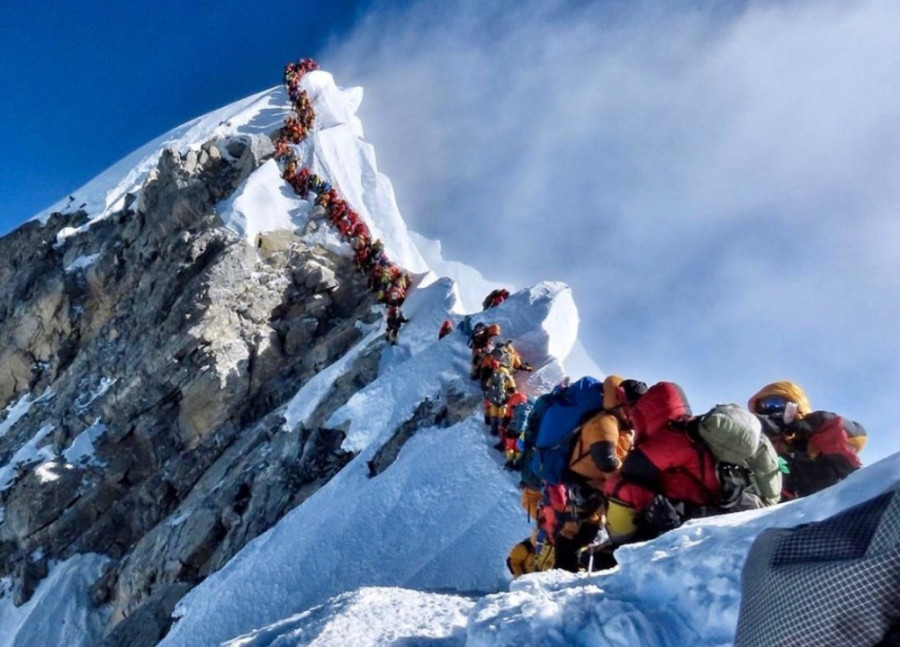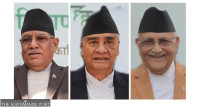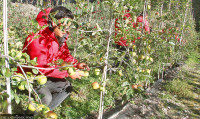National
Climbing Everest will now require a full medical history, insurance and a certificate
The Department of Tourism has come up with new mountaineering rules in the wake of a crowded season that saw nine deaths on the world’s highest peak.
Sangam Prasain
All climbers seeking a permit to climb Mount Everest will now need to disclose their full medical history, according to a set of new rules drafted by the Tourism Department.
In addition to disclosing their medical history, climbers must also submit a medical report by a certified doctor in order to obtain a permit to climb mountains in Nepal, including the world’s tallest peak.
The rules, which will come into effect from the next spring climbing season once approved, were drafted in an effort to determine that only climbers in good health attempt the high-altitude challenge, after a number of climbers died on Everest this year. Nine people died on Everest this year, the highest number of deaths during a single season in the past four years.
At least a dozen new rules are expected to be included in the amendment to the existing mountaineering regulation, according to sources at the Department of Tourism, which drafted the rules.
“As most deaths occurred due to fitness and health issues, we [the government] have come up with these strict measures,” said Mira Acharya, director at the Department of Tourism, the body responsible for issuing climbing permits. “The draft of the new rules was submitted to the Tourism Ministry last week.”
Once the Tourism Ministry approves the rules, they will be forwarded to the Cabinet for ratification.
Officials at the department said that the medical history declaration rule will allow them to determine whether a climber is fit enough to climb mountains.
“We don’t know the medical history of the climbers, but the climbers do,” said Acharya. “Based on their history, we can assess whether they can climb or not.”
Until now, climbers below the age of 16, persons with serious diseases and a criminal history were the only ones barred from climbing mountains.
“Besides these three rules, Nepal’s mountains were open for all,” said Acharya.
On December 28, 2017, the Cabinet’s Bill Committee had approved an amendment to the Mountaineering Expedition Regulation to bar double amputees and blind persons, as proposed by the Department of Tourism, in order to prevent high-altitude accidents. But in March 2018, the Supreme Court reversed the government’s ban, stating it was discriminatory.
According to the new rules, all climbers will also require mandatory insurance.
“It’s search, rescue and treatment insurance, which will allow rescues and prompt treatment if the mountaineer is ill or stuck at high altitude,” said Acharya. “The insurance will also partly cover retrieval of the body in case of death.”
Retrieving a body above the death zone, which is above 8,000 metres, can cost around $200,000 and costs to rescue people below the death zone ranges from $20,000 to $60,000, according to rescue operators, depending on the location and situation.
According to department officials, insurance coverage has been made mandatory as adventurers have been found climbing mountains with just a life insurance policy. Currently, insurance is mandatory only for climbing guides and high-altitude workers.
According to officials, they took into account the case of Kalpana Das, an Indian climber who reached the summit on May 23 this year and died while descending.
“Das was not physically fit to climb Everest right from the beginning. It also came to light that she had no other insurance coverage except her life insurance policy,” said one official at the department who did not wish to be named.
Another new rule concerns climbing experience. While the high-altitude climbing guides are already required to possess a certificate of climbing at least one mountain, climbers will now have to submit a basic mountaineering training certificate at the department to obtain a climbing permit.
However, a government panel set up to recommend measures to make climbing safer, after the May disaster on Everest, has yet to recommend an upper age limit as that could also be discriminatory and land in court, said officials.
Rules on the mobilisation of a liaison officer will also change. According to the initial draft, the government will not send individual liaison officers. “Instead, a group comprising a doctor, army and police personnel, and government officials will be mobilised on the mountain,” said the department official.
But this provision will not be implemented in the next spring climbing season, as a separate guideline will have to be prepared, according to officials.
In the wake of May’s deaths and a photo that went viral across the world, many international observers had also suggested that Nepal limit the number of permits issued or raise the permit fees. The government has decided to form a separate committee to determine a new fee to climb Everest, according to officials.
“Our objective is to manage and conserve the mountains as well as making mountain tourism commercial,” said the department official.
Government officials said that they have not come up with a policy to restrict the number of climbers on the world’s highest peak, largely due to the Visit Nepal 2020 campaign, which aims to bring in 2 million tourists next year. “We have a restriction in mind but not for next year,” said the official.
According to the department, 223 mountaineers ascended Mount Everest on May 22, setting a new record for the highest number of climbers to stand on top of the world in a single day.




 6.1°C Kathmandu
6.1°C Kathmandu










%20(1).jpg&w=300&height=200)




